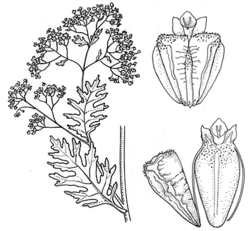Common name: Parthenium Weed
Parthenium hysterophorus L. APNI* 
Description: Erect taprooted annual up to 2 m high, rough, pubescent; mostly single-stemmed and much branched above; glandular-punctate or resin-dotted.
Leaves bipinnatifid with fine white hairs; lower leaves 5–20 cm long; upper leaves less divided and smaller.
Heads small, white, c. 4 mm diam., in terminal panicles. Ray florets with ligules c. 0.7 mm long, truncate to emarginate, white, resin-dotted. Disc florets white to cream.
Achenes black, 2 mm long, plano-convex, apex and centre of each face densely white-papillose; pappus of 2 broad membranous, white scales, c. 0.5 mm long.
Flowering: throughout year.
Distribution and occurrence: Grows in agricultural areas, from Goondiwindi to Jerilderie, and west to Nyngan and Hillston areas. Native of N & S Amer.
NSW subdivisions: *CC, *NWS, *CWS, *SWS, *NWP, *SWP
Other Australian states: *Qld *N.T.
A declared noxious weed in N.S.W. First recorded in N.S.W. in 1982, has been found in crop lands, pastures and on roadsides but is eradicated when found. Spread by farm machinery, vehicles and contaminated seed. Causes contact dermatitis and respiratory problems in humans and livestock.
Text by L. Murray
Taxon concept: Flora of NSW 3 (1992)
APNI* Provides a link to the Australian Plant Name Index (hosted by the Australian National Botanic Gardens) for comprehensive bibliographic data
***The AVH map option provides a detailed interactive Australia wide distribution map drawn from collections held by all major Australian herbaria participating in the Australian Virtual Herbarium project.
|


